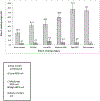Assessing 30-day quantity-frequency of U.S. adolescent cigarette smoking as a predictor of adult smoking 14 years later
- PMID: 26987520
- PMCID: PMC6119624
- DOI: 10.1016/j.drugalcdep.2016.02.043
Assessing 30-day quantity-frequency of U.S. adolescent cigarette smoking as a predictor of adult smoking 14 years later
Abstract
Background: To improve measures of monthly tobacco cigarette smoking among non-daily smokers, predictive of future non-daily monthly and daily smoking.
Methods: Data from United States National Longitudinal Study of Adolescent to Adult Health, tracking adolescents, ages 12-21, over 14 years were analyzed. At baseline, 6501 adolescents were assessed; 5114 individuals provided data at waves 1 and 4. Baseline past 30-day non-daily smokers were classified using quantity-frequency measures: cigarettes smoked/day by number of days smoked in the past 30 days.
Results: Three categories of past 30-day non-daily smokers emerged using cigarettes/month (low:1-5, moderate: 6-60, high: 61+) and predicted past 30-day smoking at follow-up (low: 44.5%, moderate: 60.0%, high: 77.0%, versus 74.2% daily smokers; rτ=-0.2319, p<0.001). Two categories of non-smokers plus low, moderate and high categories of non-daily smokers made up a five-category non-daily smoking index (NDSI). High NDSI (61+ cigs/mo.) and daily smokers were equally likely to be smoking 14 years later (High NDSI OR=0.97, 95% CI=0.53-1.80 [daily as reference]). Low (1-5 cigs/mo.) and moderate (6-60 cigs/mo.) NDSI were distinctly different from high NDSI, but similar to one another (OR=0.21, 95% CI=0.15-0.29 and OR=0.22, 95% CI=0.14-0.34, respectively) when estimating future monthly smoking. Among those smoking at both waves, wave 1 non-daily smokers, overall, were less likely than wave 1 daily smokers to be smoking daily 14 years later.
Conclusions: Non-daily smokers smoking over three packs/month were as likely as daily smokers to be smoking 14-years later. Lower levels of non-daily smoking (at ages 12-21) predicted lower likelihood of future monthly smoking. In terms of surveillance and cessation interventions, high NDSI smokers might be treated similar to daily smokers.
Keywords: Adolescents; Future smoking; Longitudinal; Non-daily smoking; Tobacco cigarette smoking.
Copyright © 2016 Elsevier Ireland Ltd. All rights reserved.
Conflict of interest statement
Conflict of interest
Other than Dr. Mahoney, the other co-authors have no financial interest in this study and no conflicts of interests to disclose. Dr. Mahoney has previously served as a consultant to Pfizer regarding Chantix® and the topic of smoking cessation, has received peer-reviewed research funding from Pfizer’s Global Research Award for Nicotine Dependence (GRAND), has conducted smoking cessation clinical trials, and has served as a paid expert witness in litigation against the tobacco industry; he also currently serves as the Medical Director for the NYS Smokers Quitline
Figures


References
-
- Benowitz NL, Henningfield JE, 1994. Establishing a nicotine threshold for addiction. The implications for tobacco regulation. N. Engl. J. Med. 331, 123. - PubMed
-
- Berg CJ, Lust KA, Sanem JR, Kirch MA, Rudie M, Ehlinger E, Ahluwalia JS, An LC, 2009. Smoker self-identification versus recent smoking among college students. Am. J. Prev. Med. 36, 333–336. - PubMed
-
- Centers for Disease Control and Prevention, 1994. Cigarette smoking among adults—United States, 1992, and changes in the definition of current cigarette smoking. MMWR 43, 342. - PubMed
-
- Centers for Disease Control and Prevention, 1996. Cigarette smoking among adults—United States, 1994. MMWR 45, 588. - PubMed
Publication types
MeSH terms
Grants and funding
LinkOut - more resources
Full Text Sources
Other Literature Sources
Medical
Miscellaneous

